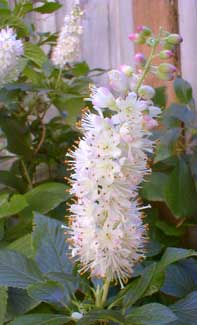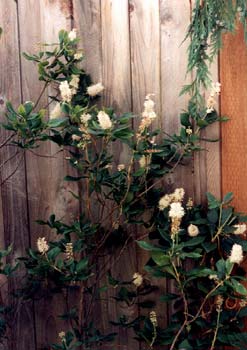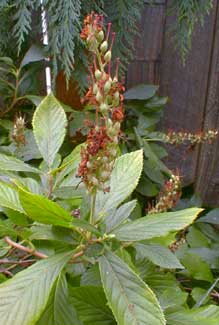
Pink Summersweet
aka Pepper Bush
aka White Alder
aka Spike Alder
aka Poor Man's Soap
"Farewell, sweet Summer,
Fragrant, fruity Summer,
Sweet, farewell!"
-George Arnold
1834-1865
1834-1865
Summersweet ( Clethra alnifolia), a close relative of alder, is a North American wildflower shrub, native to the East Coast, eastern Texas, & as far inland as Pennsylvania.
There are several Asian species of Clethra, but the American species is hard to beat. It is a popular "exotic" for European gardeners, but is under-appreciated in its homeland.
It is adaptable to climates sub-tropical or temperate, just so long as humidity or moisture is high enough for it. The summer & early autumn flowers are normally white, but the cultivar 'Pink Spire' (sometimes as one word, Pinkspire) begins in July & August with pink buds that open into faintly pinkish upright bottlebrush racemes that fade to white. There are several other cultivars to select from, but 'Pink Spire' is one of the oldest variety.
 July's pink buds are opening into full bloom by the second or third week of August & it continues flowering through most of September, occasionally into October, although generally by October all that remains is the dried-out flowers & fruit capsules.
July's pink buds are opening into full bloom by the second or third week of August & it continues flowering through most of September, occasionally into October, although generally by October all that remains is the dried-out flowers & fruit capsules.Sweetsummer's blossom spikes were a traditional soap-substitute in New England, called Fisherman's Soap Plant, Poor Man's Soap, or Soap Bush.
The clusters of dry capsule fruits hold on to the branches as long as two full years, adding to its decorative interest even when unleafed in winter. Some larger birds may eat these capsules.
The final photo on this page, below, is from late September showing the dried bottlebrushes & as-yet unripe capsules. I mistakenly cut these off the first year this shrub was in the garden, but I now leave them; minimal pruning waits until spring.
Shade tolerant, in the wild it grows under old-growth, & will bloom fine whether in sun or dappled shade. However, with too much shade the lower limbs will cease to produce leaves. It flowers best & has better late-autumn leaf color with a bit of sun. It will be densely foliaged if given a good portion of sunlight, but just as with deciduous azaleas, it is a balancing act to give it enough sun without stressing it with heat.
It likes rich, damp, humousy, acidic soil. Once established it is hardy no matter what, but does best with considerable watering. Its only possible weaknesses are prolonged dry spells which weaken it to insect attack, or alkaline soils which it deplores.
Its needs are overall very similar to rhododendrons & blueberries. It looks good in dappled shade amidst rhodies, in order to vary leaf textures & to provide blooms later in the year when rhodies are long done flowering.
When placing this shrub in the garden, two things should be kept in mind. First, the flowers are quite fragrant, the spicy scent lending summersweet its alternate name pepperbush, elsetimes sweet pepper bush or coastal pepper bush; the seed pods additionally resemble peppercorns. So it is nice to have the shrub near enough to foot traffic that it can be appreciated for its scent. But at the same time it is an exceptionally brittle shrub, & needs to be far enough off the path to not be knocked into a great deal, or limbs will certainly snap off.
Ours is growing against a fence somewhat protected by a nearby deciduous Dawn Viburnum, which blooms in winter, & which has citrusy-smelling leaves. The citrusy viburnum leaves & the spicy summersweet blooms make for a nice combination of summer scents, being more a kitcheny smell than a flowery one.
In the wild it tends to reach only four or five feet of height, in part because of breakage from being brittle. Pampered in a garden it occasionally reaches six to ten feet of height, five to eight feet of width, except for the dwarf cultivar called 'Hummingbird' which remains three feet or smaller.
 On older branches, the reddish brown bark will develop exfoliating appearance, lending further winter interest. Because it suckers & spreads by stolons, having many upright limbs, it can over time become a densely clumping bush. But with training & pruning & removal of suckers, it can be raised with more the form of a little tree with central leader.
On older branches, the reddish brown bark will develop exfoliating appearance, lending further winter interest. Because it suckers & spreads by stolons, having many upright limbs, it can over time become a densely clumping bush. But with training & pruning & removal of suckers, it can be raised with more the form of a little tree with central leader.Training & pruning for good limb structure is important because it is so late to releaf, being twiggy until mid-May, & so needs to have a handsome shape for the sake of maximizing its appeal during its prolonged leafless spell. I recall we bought our young specimen in the spring before it had many leaves, & it was heavily discounted in price because the nursery-manager didn't want to wait a few more weeks for it to regain a lively appearance. But it was really ideal to choose it before it had leafed out, so as to judge the merits of the limb structure alone.
Its beauty in winter is dependent on the gardener's capacity for aesthetic pruning, as otherwise it will become a chaotic mass of twigs. A wilder, clumpier shrub can be attractive too, but pruning is still called for because it blooms primarily on newer limbs.
It makes up for being so late to re-leaf by remaining fully leafed very long into Autumn, when other deciduous shrubs & trees are leafless, followed eventually by the winter attractiveness of the pealing bark of oldest limbs & the dried bottlebrushes & fruit pods that ripen to brown.
The last late-September photo shows that the leaves haven't as yet even started to turn. When the leaves do turn, it will be in November, & they can be brilliantly orange & yellow, although the merits of late-autumn colors varies greatly from shrub to shrub & its precise location & environmental experience. For fall foliage portraits, see the Summersweet Page of the Autumn Leaves Gallery.